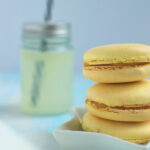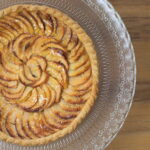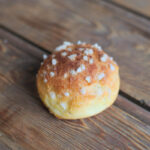Choux pastry is a technique that gives a lot of CAP pastry apprentices the willies. In my opinion, the most complicated thing about this recipe is that it’s hard to know what went wrong. You may have the impression that you’re doing everything right, but in the end your preparation doesn’t puff up or falls over. So let’s take a look at the tips and techniques for successful choux pastry!
Tips for a successful choux pastry
It’s worth noting that every pastry chef has his or her own technique for making a successful choux pastry (especially when it comes to baking). If you’re making éclairs for a Sunday lunch, don’t hesitate to try out the tips you find here and there.
At Christophe Michalak’s, for example, pastry chefs put the choux in the oven for 30 minutes before baking. This technique, combined with a well-placed cracker, gives really great results. Household ovens send air into the oven during baking, which tends to deform the choux (or eclairs in this case). If you let them puff up with the oven turned off, there’ll be no deformation.
Other people use temperature changes, opening the oven door or not… etc. Test several methods and stick to the one that works!
What’s expected of you at the CAP patisserie
Forget all these shortcuts if you’re taking the CAP pâtisserie. It’ll be old-school choux (i.e. no crackers) and baking in a static-heat oven (usually 180°C). If you’re lucky at the exam, the baking will be managed by a dedicated teacher. This prevents one of your co-candidates from putting his sponge cake in the oven when you’ve been putting your choux pastry in for 15 minutes (true story…).
The main point on which you’ll be expected to perform at CAP is consistency. So you’ll need to practice a lot until all your pieces are identical. To achieve this, you’re allowed to use templates on the exam. There are two schools of thought: those who trace their template with a felt-tip pen (velleda) on parchment paper (remembering to turn it over before poaching), and those who trace a fine line of flour using a pastry cutter (dip, place).
I’ve tested both and it’s true that the pastry cutter is faster and more professional, so go for me! To improve your regularity as such, there’s no real trick, you just have to get the hang of it.
Making the breadcrumbs
In absolute terms, choux pastry isn’t terribly complicated to make. You melt the butter and water in a saucepan, bring to the boil, add the flour, moisten with the eggs, poach, bake… and voilàààà! The problem is that when things go wrong, it’s always at the end, and it’s hard to work out why.
When making choux pastry, always proceed with caution and moderation. In the first stage, for example, when boiling the butter and water (or the water/milk mixture for a fluffier choux pastry), stop as soon as the mixture starts to boil. Otherwise, when the flour is added, the material/moisture ratio will be upset and the dough will have a poor consistency.
Once the flour has been incorporated, return to the heat to dry out the preparation, which is then called “panade”.

There are several ways to tell when a panade is ready:
- it’s in one piece
- when the pan is shaken, the panade goes “schplock-schplock”.
- the bottom of the pan is covered with a thin film
Moisturizing the choux pastry
When the panade has dried out properly, rehydrate it with eggs. But BEWARE, you don’t have to use the full quantity of eggs! In fact, depending on the absorption capacity of the flour, the rate of dehydration and the size of your eggs, you’ll need to adjust the quantity. To do this, pour all the eggs into a tray, beat quickly with a fork and gradually add to the panade. Don’t add any more eggs until the previous quantity has been well absorbed, and stop as soon as the choux pastry has reached the right consistency.
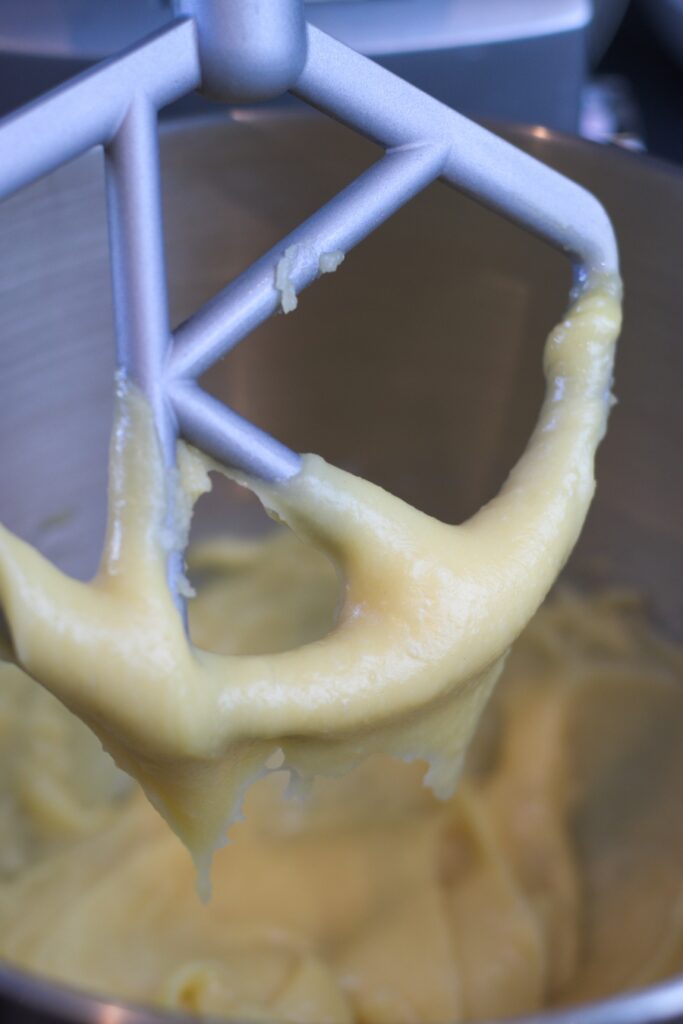
As an aside, I’ve been testing the Kmix loaned by Kenwood under CAP conditions for a few months now (following on from my article on how to choose a food processor for the CAP). I totally approve of it for choux pastry. The motor is a pleasure to use, as it doesn’t jerk, and the sheet is efficient for integrating the eggs evenly (because choux pastry by hand can sometimes be very sporty!).
How do you know if your pate a choux is the right consistency?
The 1 million euro question! There are several techniques for this. Some people use a technique called “cock’s crest”. You dip the spatula into the dough, then turn it over: if the crest stays in the air, the dough isn’t hydrated enough (you need to add more egg). If the crest falls back very quickly, the dough is too hydrated. The right consistency is reached when the crest holds together well enough.

I find it a little complicated, but I use the finger technique (avoid it on the big day, use a spatula). Make a channel in the choux pastry, which should close (otherwise the pastry will be too dry), but not too quickly (the pastry will be too hydrated). The ideal time is between 20 and 30 sec.
Once you’ve reached this stage, you’re ready to make chouquettes, éclairs or Paris-Brest!
Which pastry bag for choux pastry?
Of course, this will depend on the preparation. But for chouquettes, I use a PF 10 tip (a small 10 mm diameter tip for beginners!). For éclairs, I use a 14″ fluted tip to avoid scratching the choux pastry with a fork (but you can also use a smooth tip).
How can I prevent the choux pastry from falling over?
Choux pastry is a complicated preparation on several levels, and baking is no exception! To avoid the choux pastry falling over during baking, it’s imperative not to open the oven before the minimum 30-minute baking time. Your choux pastry is cooked when the surface is drip-free and the grooves are not moist. As choux pastry tends to soften with the filling, I advise you to over-bake it rather than risk under-baking it.
How to make choux pastry too runny?
If your choux pastry is too runny, don’t panic! Set aside the excess liquid and make a new choux pastry with half the ingredients. Stop short of incorporating the eggs, and add the excess liquid choux paste a little at a time. Once all the dough has been incorporated, top up with an egg or two if necessary, until you reach a perfect consistency.
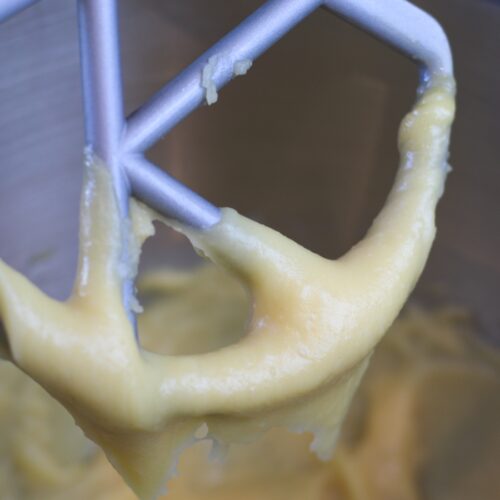
Pâte à choux
Équipement
- 1 casserole
- 1 spatule
- 2 saladiers
- 1 poche à douille
- 1 douille adaptée à la préparation réalisée
Ingredients
- 125 mL de lait
- 125 mL d'eau
- 100 g de beurre
- 10 g de sucre
- 4 g de sel
- 100 g de farine
- 4 oeufs
Instructions
Réalisation de la panade
- Faire bouillir le beurre, le lait, l'eau, le sel et le sucre.125 mL de lait, 125 mL d'eau, 4 g de sel, 10 g de sucre
- Dès que le mélange frémit, sortir du feu et ajouter la farine en une fois. Mélanger et remettre sur feu doux pour assécher la panade.100 g de farine
- Mélanger jusqu'à ce que la panade soit bien homogène (elle doit faire schplok quand on secoue la casserole).

Ajout des oeufs
- Casser les oeufs dans un bol et mélanger jusqu'à homogénéité.4 oeufs

- Lorsque les oeufs sont bien mélangés, ajouter une nouvelle petite quantité. Continuer ainsi jusqu'à avoir une bonne consistance pour la pâte à choux.

- Mettre dans une poche et pocher selon la préparation voulue : éclairs, chouquettes, Paris-Brest…



